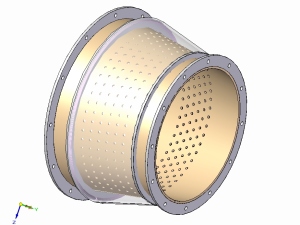Helmholtz Resonator
August 21, 2012
Here follows the explanation related to some of the experiments F. Y. B. Sc. Students perform in the Physics Laboratory. It is often found that most of the experiments done are a routine and do not find any idea or seed of information that could germinate into Application of Science. Though, I will not give any such germinating seeds, but yeah, I would definitely like to sow some seeds which should give something called PERSPECTIVE.
This post is about Helmholtz Resonator.
A Helmholtz resonator or Helmholtz oscillator is a container of gas (usually air) with an open hole (or neck or port). A volume of air in and near the open hole vibrates because of the ‘springiness’ of the air inside. A common example is an empty bottle: the air inside vibrates when you blow across the top, as shown in the diagram at left. (It’s a fun experiment, because of the surprisingly low and loud sound that results.) Also, many times a whistle using the cap of the pen.
Applications in Engineering & Acoustics
- Helmholtz resonance finds application in internal combustion engines(popularly called as Car/Bike/4 Wheeler Engines) sub-woofers and acoustics.
- In stringed instruments, such as the guitar and violin, the resonance curve of the instrument has the Helmholtz resonance as one of its peaks, along with other peaks coming from resonances of the vibration of the wood.
- The theory of Helmholtz resonators are used in motorcycle and car exhausts to alter the sound of the exhaust note and for differences in power delivery by adding chambers to the exhaust. Exhaust resonators also used to reduce potentially loud and obnoxious engine noise where the dimensions are calculated so that the waves reflected by the resonator help cancel out certain frequencies of sound in the exhaust.
- In some two-stroke engines, a Helmholtz resonator is used to remove the need for a reed valve, which is a consumable component and therefore undesirable in engines with long running time. A similar effect is also used in the exhaust system of most two-stroke engines, using a reflected pressure pulse to supercharge the cylinder.
Applications in Architecture
Helmholtz resonators are used in architectural acoustics to reduce undesirable low frequency sounds (standing waves, etc.) by building a resonator tuned to the problem frequency, thereby eliminating it.
Applications in Aircraft Design
Helmholtz resonators are also used to build acoustic liners for reducing the noise of aircraft engines, for example. These acoustic liners are made of two components:
- a simple sheet of metal (or other material) perforated with little holes spaced out in a regular or irregular pattern; this is called a resistive sheet;
- a series of so-called honeycomb cavities (holes with a honeycomb shape, but in fact only their volume matters).
Such acoustic liners are used in most of today’s aircraft engines. The perforated sheet is usually visible from inside or outside the airplane; the honeycomb is just under it. The thickness of the perforated sheet is of importance, as shown above. Sometimes there are two layers of liners; they are then called “2-DOF liners” (DOF meaning Degrees Of Freedom), as opposed to “single DOF liners”.
This effect might also be used to reduce skin friction drag on aircraft wings by 40%.
Thus, we see that Helmholtz Resonator has so many applications in Acoustics of designing sound proof buildings in Architecture or designing exhaust pipes for automobiles in Mechanical Engineering and many more.
Hope you enjoyed the post.
